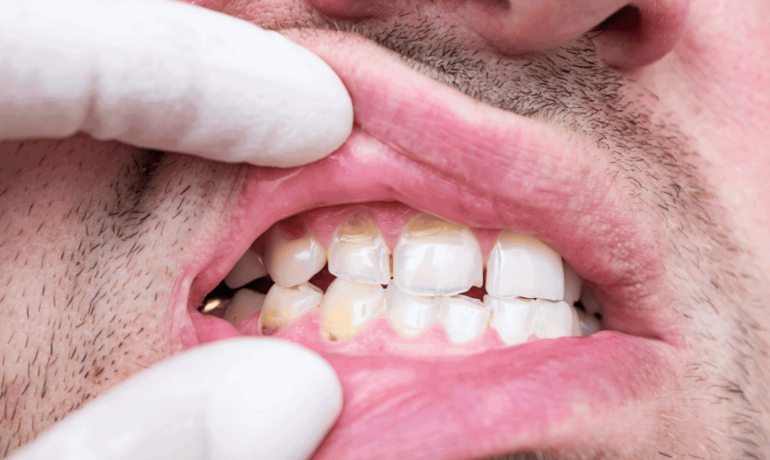We’ve all been there—that “oh-my-tooth” moment. Hearing that seemingly inaudible yet sharp cracking sound inside your mouth instantly can send panic signals to your brain. Having even a minor tooth crack or chip isn’t something you just ignore, much less fix yourself with the aid of some YouTube video.
Needless to say, you need an Upland dentist to help fix it for you!
The question now is, will you need a filling for a minor cracked tooth? Or a dental crown? A partial crown might do the trick!
There are many dental restoration options for different needs, and one is the partial crown—an effective choice for fixing minor teeth damage. This guide explains partial crowns, including their appearance, placement process, comparison to fillings, and more. Make sure to stick around so you can have an informed decision.
What is a Partial Crown?
It might sound odd, but a partial crown, also known as an inlay or onlay, is what the name suggests. Unlike a full dental crown that covers the entire tooth, a partial or three-quarter crown only covers part of the tooth’s surface, leaving more of the natural tooth structure intact. This makes it a less invasive option than a full crown, making it ideal for cases where a full crown might be excessive but a filling isn’t enough.

When To Choose a Partial Crown Over a Full Crown?
Our dentists in Upland Dental Practice often get asked this question: when do I choose a partial crown over a full crown? (Vice versa)
Choose a partial crown when tooth damage is moderate, affecting no more than about 1/3 to 1/2 of the tooth’s surface area, and is limited to specific regions, such as one or two cusps (the raised points on the tooth).
Partial crowns, including inlays or onlays, are ideal when decay or fractures are shallow to moderate in depth—typically not extending beyond the outer enamel and into the deeper dentin. This allows for the preservation of up to 70-80% of the original tooth structure, which helps maintain strength and stability without extensive reshaping.
In contrast, a full crown is more suitable for teeth with extensive damage, such as those with fractures that affect multiple cusps, decay that reaches deep into the dentin layer, or previous restorations covering more than 50% of the tooth surface. Full crowns cover the entire tooth, providing complete support and protection, especially important for teeth that have undergone root canals or for molars that bear heavy chewing forces.
Additionally, getting a partial crown is generally cheaper than having a full crown as they require less material and less tooth reduction. Nevertheless, dental crown cost always depends on its material type and the procedure’s complexity.
When to Choose a Partial Crown Over a Dental Filling
There are instances where a partial crown is a great choice, especially when tooth damage is too extensive for a filling alone but doesn’t require a full crown. Dental fillings work well for small cavities or minor damage confined to a limited area of the tooth. However, if the damage affects a larger portion of the tooth or compromises its structural integrity, a filling might not provide enough support.
A partial crown covers and protects more of the tooth’s surface than a filling, which helps prevent further damage and maintains the tooth’s stability.
The Partial Crown Procedure
Here’s a simple breakdown of what to expect if your dentist in Upland California recommends a partial crown procedure:
- Initial Evaluation: First, our dentist examines your tooth to see if a partial crown is the best restorative option. They’ll check the extent of the damage and may take X-rays to confirm that a partial crown will provide the needed support.
- Tooth Preparation: Once the decision is made, our dentist will clean the area, removing any decay or damaged parts of the tooth. This step ensures the remaining tooth is healthy and ready to bond well with the crown.
- Creating the Crown: Our dental office uses advanced technology like CEREC, which allows us to design, craft, and fit your partial crown all in one visit. Using digital scans of your tooth, CEREC can create a perfectly fitted crown, saving you from multiple appointments and temporary crowns. The result is a durable, custom crown that blends with your natural tooth.
Each step in this procedure is designed to give our patients comfortable and lasting results while preserving as much of their natural tooth as possible.
Don’t Wait for Further Tooth Damage!
If you’re dealing with a cracked or weakened tooth, a partial crown could be the perfect balance between preserving your tooth’s health and its appearance. Because a cracked tooth can’t wait, don’t hesitate to reach out to our dentist in Upland Dental Practice. Taking action early ensures a lasting, healthy smile and prevents further issues down the road.


